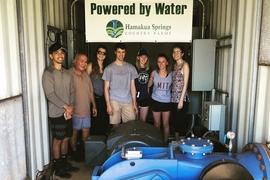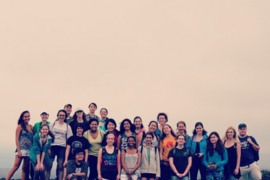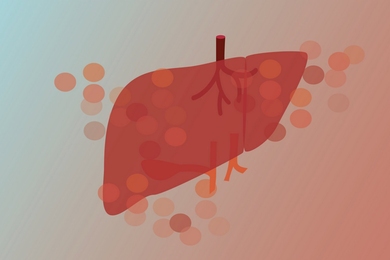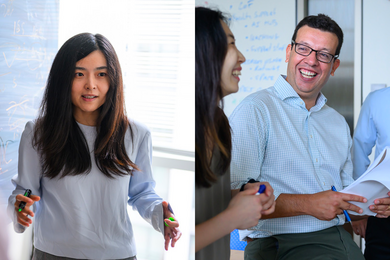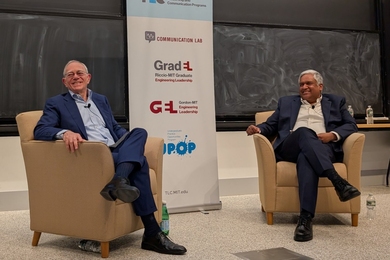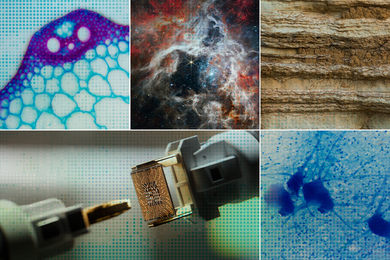A group of MIT students said “Aloha, Hawaii!” during the latest Independent Activities Period, but it wasn’t for a month of vacation. The students were tasked with conducting research and collecting data samples, which will help them further understand the environmental conditions of soil and air quality on the Island of Hawaii (a.k.a. “the Big Island”).
The research was part of the Traveling Research Environmental eXperiences (TREX) program hosted by the Department of Civil and Environmental Engineering (CEE), which offers a unique fieldwork opportunity for students.
“It is very important to us in CEE that students get hands-on research experience and tangible skills that they can take with them in their careers, especially in the field where a lot of the action is for our discipline,” says Markus Buehler, the McAfee Professor of Engineering and department head of CEE. “TREX continues to do both of these things, while producing impressive environmental research.”
TREX brings students out of the classroom to experience firsthand the benefits and challenges of fieldwork. Each year, the projects evolve and adapt to changing research interests and tools, as well as to different environmental issues in Hawaii.
“Returning to Hawaii every year has allowed us to cultivate ongoing relationships with scientists and land owners who live and work on the island,” says Ben Kocar, assistant professor of CEE and lead instructor of TREX. “As a result, our projects continuously improve, and our findings become increasingly thorough and impactful. Giving the students control over the projects also means that each year is a little bit different, because the students have their own unique backgrounds and talents.”
The students, advised by Kocar, Associate Professor Jesse Kroll, and teaching assistants Josh Moss and Ben Crawford, are the driving force behind the research. While Kocar, Kroll, Moss, and Crawford oversaw the projects and provided guidance, the fieldwork execution was the students’ responsibility. Kocar specializes in soil science, and Kroll is an expert in atmospheric chemistry, so students pursued projects on the chemical composition of soil and on monitoring particulate matter in the air.
One project worked on building and managing a network of air quality sensors across the island to monitor the levels of air pollution from volcanoes, while another project used a combination of imagery from unpiloted aerial vehicles (UAVs) and soil samples to monitor plant health. In early January, the students familiarized themselves with the basics of soil science, air quality research, and topography to prepare for the projects in Hawaii.
In addition to the scholarship behind the research, the students built air quality sensors and prepared their UAVs for the fieldwork. With the necessary skills and background information on the projects, the students were in charge of managing the projects and for the data collection.
“We were told our two main projects and given an outline of what should be completed, but all of the detailed decisions were made among our group,” explains Meghan Reisenauer, a junior in civil and environmental engineering. “We needed to decide how and where to place our air particle sensors, how and where to sample the corn and surrounding soil, as well as decide how to approach the data analysis once we had collected it.”
For the air quality project, the students also built mounts for the air quality sensors and ensured that they were angled to the correct degree, so that the solar panels would have the appropriate amount of sun. The group then installed them around the island, expanding the preexisting network created by previous TREX students. To do this, the students contacted local residents and business owners and asked to mount air quality sensors on their property.
“I learned just how important networking and simple interaction with strangers is to the success of any project. I would be lying if the concept of asking someone for permission to use their property left me without the tiniest bit of apprehension heading into our voyage,” wrote Josh Wilson, a junior in civil and environmental engineering, in a blog post about the day. What he found instead was that “everyone was more than willing to help and, moreover, interested and excited about the research we were doing.”
For the soil analysis project, teams collected soil samples from a local farm owned by Richard Ha. They compared those results with images taken with UAVs, and, scavenging a forward looking infrared (FLIR) thermal camera from a broken UAV, added an extra dimension to their data collection by capturing aerial soil and crop temperature data to determine whether heat stress was limiting crop growth. The students had to figure out how to integrate and support the FLIR camera on the UAV and how to build a sturdy, lightweight platform for the it on the UAV. Using materials from a hardware store, the students built and tested an effective platform to make their data collection possible.
A key aspect of the fieldwork was troubleshooting and changing direction at the last minute. A few days of heavy rain impeded the data collection, soaking the soil samples, making the farm inaccessible for work and impeding the UAV's ability to fly. When the government unexpectedly shut down, the students were forced to relocate from the Kilauea Military Camp in Hawaii Volcanoes National Park to nearby, privately owned housing. The move disrupted the research schedule, adding additional pressure to complete the work on time. Combined with the new housing situation, the students were challenged with maintaining an efficient workspace and performing initial analysis on the samples.
“You have this general idea of what you need to do, but you also need to adjust for weather conditions and limitations,” explains junior David Wu. “But when you’re out in the field, anything can happen, so you have to be ready for it.”
The data collection and preliminary fieldwork research from Hawaii is brought back to campus and analyzed as part of 1.092 (Traveling Research Environmental eXperience: Fieldwork Analysis and Communication) in the spring semester, giving students a chance to perform further analysis in a more controlled setting.
Despite initial setbacks and surprising results in their data collection, the students collected and analyzed a wealth of data, and presented their preliminary findings to different audiences. One night, the group met with local MIT alumni and shared their findings and research methods.
“There were alums from all different majors, who each asked very in-depth questions about their field of study in relation to our projects with the particle sensors and drone usage,” Reisenauer wrote in a blog post. “Although we didn’t have all the answers, we did our best explaining our work and fielding questions from the room.”
At the end of the program, the group also presented their research and preliminary results to local citizens of the Big Island.
“When we presented to the public, their response and questions were much broader [than the alumni questions]; they asked mainly about what we thought the long-term effects could be, or our prediction of the material in other air particles they had dealt with,” Reisenauer recalls. “They certainly seemed appreciative of our research into an issue that affects them almost every day, so it was satisfying to show our hard work into the topic!”
In addition to collecting and analyzing data, the students also partook in local activities such as hiking around the Kilauea Iki Crater and studying the plants and ecosystem that has developed at the site; snorkeling and learning about local fish species and coral; and visiting a local coffee farm, using the location as a test site for the UAV.
“Besides the beaches that people think of, there’s a lot of cool history and a lot of ecosystems in Hawaii,” Wu says. “The Big Island has almost every type of ecosystem, from deserts and rainforests, to mountains 14,000 feet tall. Since it’s so isolated, it was a good place to do research. It was like a research playground.”




